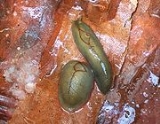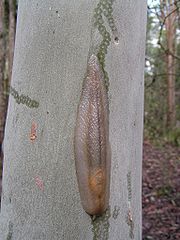
Red triangle slug
Encyclopedia
The red triangle slug, scientific name Triboniophorus graeffei, is a species
of air-breathing land slug
, a terrestrial
pulmonate gastropod mollusk in the family Athoracophoridae
, the leaf-veined slugs.
This large (up to 14 cm), often colorful and striking-looking species is found in eastern Australia
. It is Australia's largest native land slug. It is a common part of the fauna
.
Triboniophorus graeffei is the type species
of the genus Triboniophorus
.
to Queensland
.
Solem (1959) mentioned a possible introduction of this species to the New Hebrides
, but no material was available to confirm it.
s, woodland
and heath
s.
 These slugs graze on algae
These slugs graze on algae
which grows on the surface of the smooth bark of some eucalyptus trees and on rocks. Sometimes the slugs enter houses and have been known to graze on the mold
that grows on bathroom walls.
s, and like other leaf-vein slugs they have an indented pattern on their dorsum which resembles that of a leaf. The body length is up to 14 cm.
They are very variable in color. Individual slugs can be white, off-white, yellow, dark or light grey, beige, pink, red, or olive green. Each of the color forms have a red (possibly orange, magenta, or maroon) triangle on the mantle
surrounding the pneumostome
, and a red line at the edge of the foot. The texture of the dorsum of the slug can be smooth or very rough.
Juveniles lack the typical red foot border and red triangle of the adults but have three dark grey stripes running down the dorsal surface of their body and have the triangular mantle shield outlined with grey.
Research is currently being carried out in an attempt to determine if some of the different colourations may actually represent different species or subspecies.
, showing color variation, varying degrees of contraction and body shape.
Photographs of the various different color forms:
Species
In biology, a species is one of the basic units of biological classification and a taxonomic rank. A species is often defined as a group of organisms capable of interbreeding and producing fertile offspring. While in many cases this definition is adequate, more precise or differing measures are...
of air-breathing land slug
Slug
Slug is a common name that is normally applied to any gastropod mollusc that lacks a shell, has a very reduced shell, or has a small internal shell...
, a terrestrial
Terrestrial animal
Terrestrial animals are animals that live predominantly or entirely on land , as compared with aquatic animals, which live predominantly or entirely in the water , or amphibians, which rely on a combination of aquatic and terrestrial habitats...
pulmonate gastropod mollusk in the family Athoracophoridae
Athoracophoridae
Athoracophoridae, common name the leaf-veined slugs, are a family of air-breathing land slugs, terrestrial pulmonate gastropod mollusks in the infraorder Stylommatophora, the stalk-eyed snails and slugs...
, the leaf-veined slugs.
This large (up to 14 cm), often colorful and striking-looking species is found in eastern Australia
Australia
Australia , officially the Commonwealth of Australia, is a country in the Southern Hemisphere comprising the mainland of the Australian continent, the island of Tasmania, and numerous smaller islands in the Indian and Pacific Oceans. It is the world's sixth-largest country by total area...
. It is Australia's largest native land slug. It is a common part of the fauna
Fauna
Fauna or faunæ is all of the animal life of any particular region or time. The corresponding term for plants is flora.Zoologists and paleontologists use fauna to refer to a typical collection of animals found in a specific time or place, e.g. the "Sonoran Desert fauna" or the "Burgess shale fauna"...
.
Triboniophorus graeffei is the type species
Type species
In biological nomenclature, a type species is both a concept and a practical system which is used in the classification and nomenclature of animals and plants. The value of a "type species" lies in the fact that it makes clear what is meant by a particular genus name. A type species is the species...
of the genus Triboniophorus
Triboniophorus
Triboniophorus is a genus of air-breathing land slugs, terrestrial pulmonate gastropod mollusks in the family Athoracophoridae, the leaf-veined slugs.-Species:Species within this genus include:...
.
Distribution
This slug species occurs on the east coast of Australia, from New South WalesNew South Wales
New South Wales is a state of :Australia, located in the east of the country. It is bordered by Queensland, Victoria and South Australia to the north, south and west respectively. To the east, the state is bordered by the Tasman Sea, which forms part of the Pacific Ocean. New South Wales...
to Queensland
Queensland
Queensland is a state of Australia, occupying the north-eastern section of the mainland continent. It is bordered by the Northern Territory, South Australia and New South Wales to the west, south-west and south respectively. To the east, Queensland is bordered by the Coral Sea and Pacific Ocean...
.
Solem (1959) mentioned a possible introduction of this species to the New Hebrides
New Hebrides
New Hebrides was the colonial name for an island group in the South Pacific that now forms the nation of Vanuatu. The New Hebrides were colonized by both the British and French in the 18th century shortly after Captain James Cook visited the islands...
, but no material was available to confirm it.
Habitat
Red triangle slugs are found in damp situations in various habitats, including city gardens, forestForest
A forest, also referred to as a wood or the woods, is an area with a high density of trees. As with cities, depending where you are in the world, what is considered a forest may vary significantly in size and have various classification according to how and what of the forest is composed...
s, woodland
Woodland
Ecologically, a woodland is a low-density forest forming open habitats with plenty of sunlight and limited shade. Woodlands may support an understory of shrubs and herbaceous plants including grasses. Woodland may form a transition to shrubland under drier conditions or during early stages of...
and heath
Heath (habitat)
A heath or heathland is a dwarf-shrub habitat found on mainly low quality acidic soils, characterised by open, low growing woody vegetation, often dominated by plants of the Ericaceae. There are some clear differences between heath and moorland...
s.
Life habits

Algae
Algae are a large and diverse group of simple, typically autotrophic organisms, ranging from unicellular to multicellular forms, such as the giant kelps that grow to 65 meters in length. They are photosynthetic like plants, and "simple" because their tissues are not organized into the many...
which grows on the surface of the smooth bark of some eucalyptus trees and on rocks. Sometimes the slugs enter houses and have been known to graze on the mold
Mold
Molds are fungi that grow in the form of multicellular filaments called hyphae. Molds are not considered to be microbes but microscopic fungi that grow as single cells called yeasts...
that grows on bathroom walls.
Description
These slugs have two, not four, tentacleTentacle
A tentacle or bothrium is one of usually two or more elongated flexible organs present in animals, especially invertebrates. The term may also refer to the hairs of the leaves of some insectivorous plants. Usually, tentacles are used for feeding, feeling and grasping. Anatomically, they work like...
s, and like other leaf-vein slugs they have an indented pattern on their dorsum which resembles that of a leaf. The body length is up to 14 cm.
They are very variable in color. Individual slugs can be white, off-white, yellow, dark or light grey, beige, pink, red, or olive green. Each of the color forms have a red (possibly orange, magenta, or maroon) triangle on the mantle
Mantle (mollusc)
The mantle is a significant part of the anatomy of molluscs: it is the dorsal body wall which covers the visceral mass and usually protrudes in the form of flaps well beyond the visceral mass itself.In many, but by no means all, species of molluscs, the epidermis of the mantle secretes...
surrounding the pneumostome
Pneumostome
The pneumostome is a feature of the external body anatomy of an air-breathing land slug or land snail. It is a part of the respiratory system of gastropods....
, and a red line at the edge of the foot. The texture of the dorsum of the slug can be smooth or very rough.
Juveniles lack the typical red foot border and red triangle of the adults but have three dark grey stripes running down the dorsal surface of their body and have the triangular mantle shield outlined with grey.
Research is currently being carried out in an attempt to determine if some of the different colourations may actually represent different species or subspecies.
Gallery
Various shots of Triboniophorus graeffei on the bark of Sydney Blue Gums, near Dungog, AustraliaAustralia
Australia , officially the Commonwealth of Australia, is a country in the Southern Hemisphere comprising the mainland of the Australian continent, the island of Tasmania, and numerous smaller islands in the Indian and Pacific Oceans. It is the world's sixth-largest country by total area...
, showing color variation, varying degrees of contraction and body shape.
Further reading
Pfeiffer W. 1898. Anatomische und histologische Bemerkungen über Triboniophorus Graeffei Humbert. Sitzber. Ges. natf. Freunde, Berlin.External links
Photographs on the life history etc:- Photo of about-to-hatch eggs and newly hatched juvenile, from Bill Rudman's site
- Feeding tracks on a tree trunk
- Showing detail of the head and triangle with pneumostome open
Photographs of the various different color forms:
- A mating pair of the white form on a tree trunk
- A yellow one with magenta markings, in the contracted state
- A dark yellow or orange individual with dark red markings
- A very good close-up photo of an actively crawling greenish-grey slug
- A photo showing a wide red margin of the foot on a cream-colored individual
- A cream-colored individual wrapped around a twig with pneumostome closed
- A beige individual with orange markings
- A solidly bright red individual

